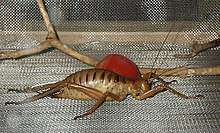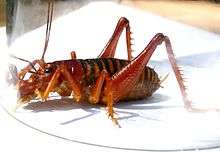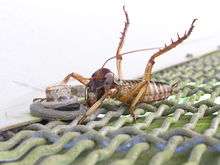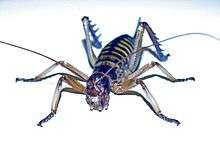Anostostomatidae
| Anostostomatidae | |
|---|---|
 | |
| Poor Knights giant weta, Deinacrida fallai Overall length 20 cm (8 in) | |
| Scientific classification | |
| Kingdom: | Animalia |
| Clade: | Euarthropoda |
| Class: | Insecta |
| Order: | Orthoptera |
| Suborder: | Ensifera |
| Superfamily: | Stenopelmatoidea |
| Family: | Anostostomatidae Saussure, 1859 |
| Subfamilies and genera | |
|
See text. | |
Anostostomatidae is a family of insects in the order Orthoptera, widely distributed in the southern hemisphere. It is named Mimnermidae or Henicidae in some taxonomies, and common names include king crickets in South Africa and weta in New Zealand (although not all weta are in Anostostomatidae). Prominent members include the Parktown prawn of South Africa, and the giant weta of New Zealand. The distribution of this family reflects a common ancestry before the fragmenting of Gondwana.
General characteristics
By virtue of their ability to cope with variations in temperature, members of the family Anostostomatidae can be found in a variety of environments including alpine, forests, grasslands, shrub lands and urban gardens. The family is widely distributed across southern hemisphere lands including South America, Australia, South Africa and New Zealand. They are nocturnal and many are flightless although several flying species exist in Australia. The diet is diverse, rarely consisting of leaves, and more commonly a combination of other insects, fungi, dead animals, and fruit. An Australian king cricket can overpower and eat funnel-web spiders.[1]

Taxonomy and evolution
At least one Cretaceous fossil of an anostostomatid-like cricket is known from Australia but has not been described. The modern distribution of this family in the southern hemisphere has led to speculation that members of this group owe their distribution to the breakup of the ancient supercontinent Gondwana. This may be the case but evidence for the large scale if not total submergence of continental crust in the New Zealand and New Caledonian region in the Oligocene, indicates the possibility that weta have arrived in these locations at least, since re-emergence of land. The fact that anostostomatid crickets also occur on some Japanese islands supports this possibility.

King crickets of South Africa
The best-known species is the Parktown prawn, not to be confused with the well-known Koringkrieke or armoured ground crickets, which never have been in the family Anostostomatidae.
Henicus monstrosus is a nocturnal anostostomatid. The males are unusual in their anatomy; their heads are disproportionately large and bear forward-directed prongs. They have extremely long, curved mandibles that are functional, but seem to play no part in the eating process.[2]
Weta of New Zealand

Five genera of New Zealand weta are part of the family Anostostomatidae:
- Giant weta (Deinacrida)
- Ground weta (Hemiandrus)
- Northland tusked weta (Anisoura)
- Tree weta (Hemideina)
- Tusked weta (Motuweta)
(The cave weta species belong to a different family, the Rhaphidophoridae.)

Subfamilies and genera
- Subfamily Anostostomatinae Saussure, 1859
- Aistus
- Anabropsis
- Anostostoma
- Apotetamenus
- Apteranabropsis
- Bochus
- Borborothis
- Brachyporus
- Carcinopsis
- Cnemotettix
- Cratomelus
- Exogryllacris
- Glaphyrosoma
- Gryllotaurus
- Hemiandrus, ground weta
- Henicus
- Hydrolutos
- Hypocophoides
- Hypocophus
- Leponosandrus
- Libanasa
- Libanasidus, king crickets
- Licodia
- Lutosa
- Motuweta, tusked weta
- Nasidius
- Neolutosa
- Onosandridus
- Onosandrus
- Papuaistus
- Paterdecolyus
- Penalva
- Spizaphilus
- Subfamily Deinacridinae
- Anisoura, Northland tusked weta
- Deinacrida, giant weta
- Gryllacropsis (from India, only tentatively assigned to Deinacridinae)
- Hemideina, tree weta
- Subfamily Leiomelinae
Literature
- Elizabeth Pennisi (2017). "Saving the 'god of ugly things': New Zealand battles to bring back its rodent-sized insects". Science. doi:10.1126/science.aan6940.
- Johns, P.M. 1997: The Gondwanaland weta: family Anostostomatidae (formerly in Stenopelmatidae, Henicidae or Mimnermidae): nomenclatural problems, world checklist, new genera and species. Journal of Orthoptera Research, 6: 125–138. ISSN 1082-6467, JSTOR 3503546
References
- ↑ King Cricket eating Funnel-web-Spider at Australian Museum website.
- ↑ African Insect Life - SH Skaife (Longmans Green & Co,1953)
External links
| Wikispecies has information related to Anostostomatidae |
- Family Anostostomatidae Saussure, 1859 at Orthoptera Species File Online